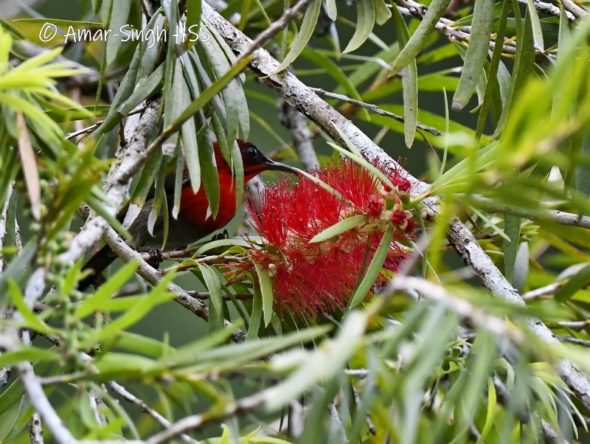

The Crimson Sunbird Aethopyga siparaja siparaja is a reasonably common sunbird and I often observe it at the fringes of Ipoh city and in ‘wilder’ gardens. I had an opportunity in the past week (last week of May 2022) to have some extended observations. This short note is to update the food sources for the species that I have observed with a brief review of the literature.
Food Items Personally Observed
- Callistemon species(Bottlebrush) – an exotic plant, nectar feeding, conventional technique.
- Acacia mangium– nectar feeding, conventional technique.
- A wild Ipomoea species – nectar feeding, conventional technique.
- Holmskioldia sanguinea(Chinese Top Hat plant) – an exotic plant, nectar feeding, conventional technique, a particular favourite of this sunbird.
- Bauhinia blakeana(Hong Kong Orchid Tree) – exotic plant, nectar feeding, conventional technique.
- Combretum constrictum (Powderpuff Combretum) – exotic plant, nectar feeding, conventional technique.
- Manihot esculenta Cassava Flower; local name Pokok Ubi Gajah) – native plant, nectar feeding, conventional technique.
- Malvaviscus arboreus(Wax Mallow or Ladies Teardrop) – exotic plant, nectar feeding, conventional technique.
- Hibiscus rosa-sinensis(Hibiscus ‘Brilliant’ cultivar) – native distribution is uncertain, nectar feeding, nectar robbing technique.
- Dendrophthoe pentandra(Malayan Mistletoe) – native plant, nectar & fruit feeding, conventional technique.
- Scurrula ferruginea(Rusty-leaf Mistletoe) – native plant, nectar feeding, conventional technique.
- Averrhoa carambola(Starfruit tree) – native plant, nectar feeding, conventional technique.
- Euphorbia tithymaloides(Devil’s Backbone) – exotic plant, nectar feeding, conventional technique.
- Cocos nucifera(Coconut) – native plant, nectar feeding, conventional technique.
- Feeding on spiders at spider web.
- Feeding on an invertebrate/larvae.
Food Items from the Literature, Online Databases and brief Internet Image Search
- Nectar of the Etlingera elatior (Torch Ginger or Bunga Kantan) (Wee 2009)
- Nectar of the Mimusops elengi (Tanjong Tree, Bunga Tanjung or Spanish Cherry) (Efloraofindia)
- Nectar of the Poikilospermum suaveolens– flowers eaten (Wee YC 2017)
- Wells (2007) notes that the “flowers commonly visited include gingers and the lily Canna indica, robbed of nectar by being punctured through the corolla-base”.
- Cheke and Mann (2001) note that food sources include “Nectar, insects and spiders. Known food plants include Butea monosperma, Cannasp., Caryopteris sp., Erythrina indica, Gliricida sp., Hibiscus sp., Leucosceptrum sp., unidentified mistletoes Loranthaceae, Prunus sp., Salmaria malabarica, Woodfordia sp. and unidentified Zingiberaceae”.
- Lantanaspecies. (DreamTime)
- Heliconia species (Lobster claws flower) (Macaulay Library 2022).
- Strelitzia species (Bird of Paradise flower) (Macaulay Library 2022).
- Passiflora coccinea(Red Passion Flower) (Macaulay Library 2022).
There are more nectar sources seen on an online image search and in the Macaulay Library but I am not able to identify the plants. I am sure the nectar sources are more diverse than listed here and often opportunistic.
In summary, the diet appears to be predominantly nectar. I suspect we will see more animal prey (insects) when observing feeding of juveniles.
References:
- Wee YC (2009). A male Crimson Sunbird and the torch ginger flowers. Bird Ecology Study Group. <https://besgroup.org/2009/01/09/a-male-crimson-sunbird-and-the-torch-ginger-flowers/>.
- efloraofindia – Database of Plants of Indian Subcontinent- developed by the members of Efloraofindia Google Group <https://sites.google.com/site/efloraofindia/species/m—z/s/sapotaceae/mimusops/mimusops-elengi>
- Wee YC (2017). Plant-Bird Relationship (Version 3.0). Bird Ecology Study Group. <https://besgroup.org/2017/10/01/plant-bird-relationship-version-3-0-2/>
- Wells, D.R. (2007). The birds of the Thai-Malay Peninsula: Vol. 2 (Passarines). Christopher Helm, London.
- Robert A Cheke, Clive F Mann, Richard Allen (2001). Sunbirds: A Guide to the Sunbirds, Flowerpeckers, Spiderhunters and Sugarbirds of the World. Helm Identification Guides.
- DreamTime stock image search. <https://www.dreamstime.com/crimson-sunbird-crimson-sunbird-aethopyga-siparaja-species-bird-sunbird-family-which-feed-female-has-image142609139>
- Macaulay Library (images filters for foraging or feeding) <https://search.macaulaylibrary.org/catalog?taxonCode=eacsun1&mediaType=photo&sort=rating_rank_desc&tag=foraging_eating>
Dato’ Dr Amar-Singh HSS
Ipoh, Perak, Malaysia
Note to readers: If you like this post please tap on the Like button at the left bottom of page.








